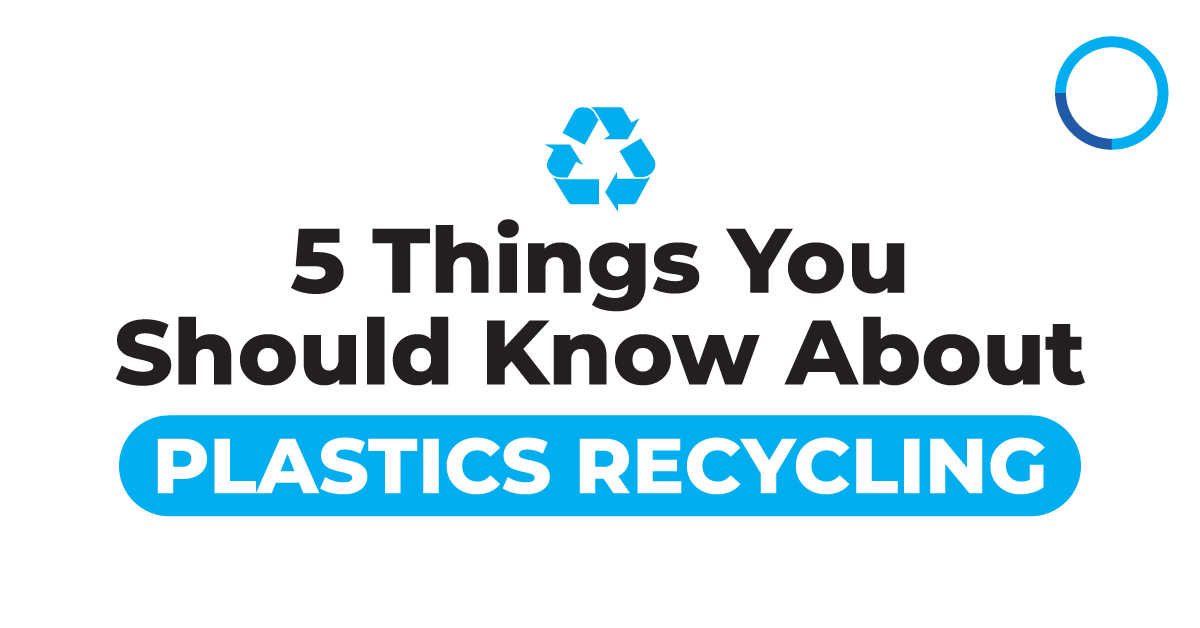Innovating, creating, and buying products made of recycled materials is essential to reducing our environmental footprint. It’s also an important part of moving towards a “Closed Loop process” where plastics are created, used, then recycled for use in new products.
As we move towards a more sustainable world, it’s important to understand the ins-and-outs of plastic recycling.
Here are 5 things you need to know about recycling plastics.
1. Labels can help you understand plastics
Labels and symbols can help you understand whether a product is made of recycled material or is recyclable. Here are some important things to understand when looking at labels.
First, you’ll often see the recycling symbol — the three chasing arrows — with a number on it. That number is the Plastic Resin Identification Code, telling you what type of plastic is in the product.
- “1” signifies Polyethylene Terephthalate (PET) — the most common component in plastic drink bottles
- “2” signifies High-Density Polyethylene (HDPE) — used in products like milk containers, oil containers, shampoo bottles, etc.
- “3” signifies Polyvinyl Chloride (PVC) — used in pipes, siding, flooring etc.
- “4” signifies Low-Density Polyethylene (LDPE) — used in plastic bags, six-pack rings, tubing etc.
- “5” signifies Polypropylene (PP) — auto parts, industrial fibres, food containers etc.
- “6” signifies Polystyrene (PS) — used in plastic utensils, Styrofoam, cafeteria trays etc.
- “7” signifies other plastics such as acrylic, nylon, polycarbonate and polylactic acid (PLA)
While the Plastic Resin Identification Code tells you the plastic types, it doesn’t tell you whether it’s recycled. Even if the number is within the recycling symbol! In fact, National Geographic estimates that more than 90 percent of all plastics are never recycled!
Second, ecolabels are granted to products that meet certain sustainability benchmarks. For example, the US Electronic Product Environmental Assessment Tool (EPEAT) is an ecolabel that certifies a product has been made using post-consumer recycled plastic, responsible end-of-life management is offered, and energy efficiency practices. Another ecolabel is the UL 2809 validation, which acknowledges a product’s post-consumer recycled (PCR) content and the efficacy of its closed-loop process.
2. Recycle Your E-Waste
As the world becomes digitally interconnected and mobile devices continue proliferating, there’s an increasing problem of what to do with that electronic waste or “e-waste” at end-of-use.
From old smartphones to computers and mice, e-waste is now the fastest-growing waste stream in the world. In 2018, the World Economic Forum estimated the e-waste stream had reached 48.5 million tonnes.
Consumers can play their part in closing the loop by making plastic-conscious buying decisions and choosing to recycle their e-waste.
Many communities have e-waste drop off sites where old technology is disassembled and repurposed. If these facilities do not exist near you and the product is still functional, consider donating the technology to those in need.
3. Biodegradable Plastic Often Requires Industrial Composting
Biodegradable plastics are usually made from plants such as bamboo or sugarcane rather than fossil fuels. They are designed to break up when exposed to microorganisms and follow rigorously controlled conditions of temperature and humidity in industrial environments.
However, you should know that ‘biodegradable’ plastics do not naturally compost. In order to decompose, these plastics must go through a recycling process where anaerobic digesters break down the material in a highly-controlled environment. Many local recycling facilities do not possess the technology to do this.
We’re a long way from throwing bio plastics in the household compost pile to decompose, but we can ensure bio plastics make it to an industrial compost facility or simply make conscious buying decisions to minimize our plastic usage.
4. Saying Goodbye to Single-Use Plastics
Canada is moving towards banning single-use plastics in 2021 and beyond.
Canada’s legislation aims to eliminate plastic products that are designed to be used once, then disposed of.
Once enacted, Canada will join the over 35 nations across the world that have already banned single-use plastics, including the UK, France, and Italy.
Single-use plastics make up most of the plastic litter found in Canadian freshwater, which then breaks down to create hazardous microplastics.
From bringing travel utensils with you, to skipping on a straw, consumers can help minimize their single-use plastic intake to further reduce their environmental footprint.
5. Circular Economies are the Future
The circular economy model is a sustainable alternative where materials are recycled and then repurposed at the end of their life, rather than disposed of.
A circular economy doesn’t happen by accident. It’s designed intentionally, per the Ellen MacArthur Foundation, a circular economy builds on three principles:
- Designing out waste and pollution
- Keeping products and materials in use
- Regenerating natural systems
Lavergne’s goal is to move closer to “Infinite Recycling” — a pure Closed Loop process — where products made with recycled plastics are recycled so they’ll live again as raw material in new products.
It’s More than Recycling
At Lavergne, we’re not only recycling — we’re continually developing new ways to make new plastics using old plastics. We believe the world has already created enough plastics to meet all our future needs.
Subscribe to the Lavergne newsroom today.



